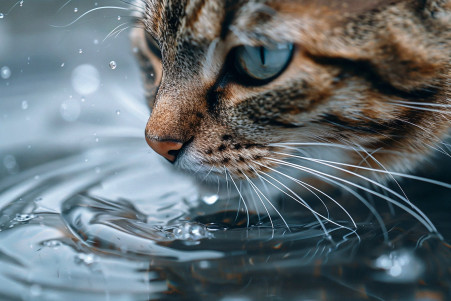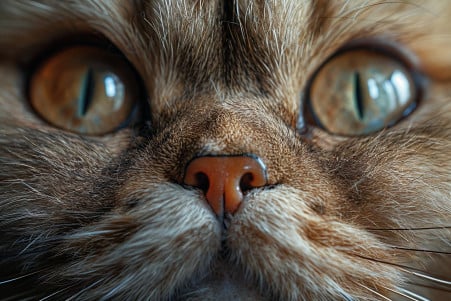Why Do Cats Hate Cold Water? An Evolutionary Perspective
1 June 2024 • Updated 31 May 2024

If you’ve ever wondered whether your cat would enjoy a cold drink or a dip in a cold pool as much as they enjoy lounging in the sun, you’re not alone. Cats hate cold water, and for good reason - as desert animals, they are not adapted to cold temperatures and are at risk of hypothermia. That said, some cats can learn to tolerate a warm bath if they are gradually introduced to the experience. Still, most cats would rather keep their fur coats dry and toasty.
In this article, we’ll explore research from a variety of fields to explain why most cats hate cold water. By learning about the evolutionary history, biological traits, and behaviors of our feline friends, you’ll come to understand why it’s a bad idea to try to soak a cat in cold water. In the process, you’ll develop a greater understanding of and respect for cats and their special place in the world.
Why do cats hate cold water?
Evolutionary Origins: Desert Dwellers and Water Aversion
House cats are descended from the Near Eastern wildcat, which lived in the dry deserts and scrublands of the Middle East, where water was scarce, notes Four Paws. This environment led to the instinctual behaviors and physical traits that cats developed to conserve water.
According to Rover, a cat’s aversion to water is an evolutionary adaptation to their environment. If a cat got wet, it would have a harder time hunting and be more vulnerable to predators. In addition, cats’ fastidious grooming habits are a result of their need to keep their fur coats dry and well-insulated in the desert.
Although some cats like the Turkish Van have evolved to be more tolerant of water because they lived near bodies of water, most cats have an instinctual fear of water due to their ancestors’ experiences. As a result, the aversion to water is deeply ingrained in cats, who needed to stay dry to survive, explains the study highlighted by PMC.
Biological Mechanisms: Thermoregulation and Water Sensitivity
Cats have specific biological ways of regulating their body temperature, and when these are thrown off by cold water, it can lead to hypothermia. According to How Cats Cool Down | Spot®, cats' fur coats are thermal insulators, but when they get wet, they lose their insulating properties and can lead to a rapid loss of body heat. Cats also use evaporative cooling and vasodilation to cool down, but these methods are less effective when a cat is wet.
Meanwhile, in How Do Cats Cool Themselves Off?, the authors note that cats' well-developed senses of smell and taste can make them more sensitive to odors and contaminants in water. The Physiological and Behavioral Mechanisms of Thermoregulation in Mammals - PMC also explains that cats show signs of heat stress and hypothermia that include lethargy, panting, disorientation, and abnormal heart rates.
Behavioral Responses: Avoidance and Aggression
Cats show a variety of behavioral responses to cold water, including avoidance, fear, and aggression. As noted by Catster, cats may hiss, jump, or try to run away when they are suddenly exposed to cold water because it makes them feel out of control. This negative response is a result of their history as desert animals who are not well-suited to cold temperatures.
Negative experiences with water when they are kittens can lead to cats having a lifelong aversion or even a phobia of water, according to First For Women. On the other hand, some breeds like the Turkish Van are more accepting of water due to their ancestors living in areas near lakes and rivers.
While most cats prefer to stay dry and warm, positive reinforcement and desensitization can help some cats learn to tolerate water, according to Project Pawsitivity and Catster. Still, even with the best training, most domestic cats' natural aversion to cold water is hard to overcome.
Health Risks: Hypothermia, Frostbite, and Other Dangers
One of the most serious health risks of cold water exposure in cats is hypothermia. According to PetMD, clinical signs of hypothermia include shivering, weakness or lethargy, collapse or coma, cool skin temperature, tachypnea with mild hypothermia and bradypnea with severe hypothermia, hypotension, and arrhythmias.
PetMD also notes that even though cats have fur, exposure to cold environmental temperatures, especially when wet, can lead to hypothermia. This can lead to the failure of vital organs, which can cause central nervous system depression, changes in heart rate and rhythm, and changes in blood pressure and respiration.
Frostbite is also a risk, especially for extremities like the ears, tail, and paws, according to Bond Vet. Mobile Vet M.D. adds that the ears, paws, and tail are particularly vulnerable, and clinical signs include skin that is discolored, cold, and swollen.
Immediate veterinary care is needed to ensure the cat is properly rewarmed and to prevent further complications. PetMD explains that external rewarming can be done with blankets, warm water bottles, and heating pads, and internal rewarming may be necessary in severe cases. Preventative measures, such as limiting time outdoors and providing warm, dry shelter, can also help protect cats from these risks.
How to Get Cats Used to Water: Slow Exposure and Positive Reinforcement
Although most cats will never like water, some can be trained to tolerate it through positive reinforcement, notes Project Pawsitivity. The key is to start when kittens are young by getting them used to the bathroom, the sound of running water, and the feel of damp surfaces.
Pet owners can then use treats, toys, and praise to make sure that the kittens have positive experiences with these water-related stimuli, says Catster. Slowly increasing exposure, from wet washcloths to shallow, warm water in the bathtub, can help some cats build a tolerance to water.
That said, as First For Women points out, it's important to make sure that you're patient, take things slowly, and never put a cat in a situation where they feel stressed or scared. With practice, some cats can learn to tolerate water, but most cats will always have a strong instinct to avoid it.
Cats' dislike of cold water is a result of a number of evolutionary, biological, and behavioral factors. Knowing this can help us better understand the needs of our feline friends and make sure that we are meeting them. Although some cats can be trained to enjoy water, most cats will always prefer to stay as dry and warm as possible.
Therefore, it is important to make sure that we are respecting their natural instincts and making sure that they have access to warm, dry places. That said, some cats can be trained to enjoy water, so long as they are given the time and space to learn.


